http://www.sportscollectorsdaily.com/vet-cancer-selling-card-collection/
|
Here is the link to my story on Sports Collectors Daily about Brad Solomon, an Iraqi war veteran who is suffering from blood cancer. To make ends meet (the VA covers his medical bills), Brad is selling his card collection. And total strangers in the Denver area are buying his cards to help him meet his goal: http://www.sportscollectorsdaily.com/vet-cancer-selling-card-collection/
0 Comments
Here is a link to a story I wrote for Sports Collectors Digest about a man from the Chicago area who pulled a Precious Metal Gems Emerald insert of Michael Jordan, numbered 001/100. He is now auctioning the card on eBay, and it already has topped $84,000. Could $100,000 or more be in the cards?
http://www.sportscollectorsdaily.com/price-jordan-card-soaring-auction/ Here is the link to my story on Sports Collectors Daily, previewing 2015 Panini America's Gridiron Kings football, which is set for release in early October. Check out some of the card images, too ...
http://www.sportscollectorsdaily.com/panini-revives-gridiron-kings-football/ A nearly complete (one card is missing) master set of the T-205 gold border set will be the first item up for bid in Huggins and Scott's auction, which begins today. Here is the link to my story on Sports Collectors Daily:
http://www.sportscollectorsdaily.com/huggins-scott-showcasing-auction-items-at-national/ 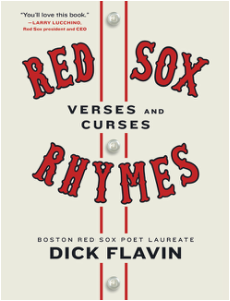 It is easy to rhapsodize about the Boston Red Sox. After all, for many years they were major-league baseball’s version of a Greek tragedy. The brightest stars of literature gravitated toward them. John Updike wrote a memorable essay about the final at-bat of Ted Williams’ storied career. Horror writer Stephen King has been seen at Fenway Park, wearing a Red Sox cap and rooting for the home team. Robert Frost lived in Vermont for 42 years and recited his poem “The Gift Outright” at President John F. Kennedy’s inauguration in January 1961. Had the Red Sox existed in the 19th century, New England natives Henry David Thoreau, Emily Dickinson, Nathaniel Hawthorne and Henry Wadsworth Longfellow undoubtedly would have rooted for them. You don’t see poetry about Boston’s hated rivals, the New York Yankees. The Yankees have those 40 American League titles and 27 World Series titles and exude the confidence of a stock broker reading the Wall Street Journal. The Red Sox bring out the lyrical best of their fans. Dick Flavin is the latest muse for the Red Sox. By day, he is the public address announcer at Fenway Park. His book, “Red Sox Rhymes: Curses and Verses” (William Morrow; hardback; $19.99; 206 pages), is a fun and whimsical collection of poems Flavin has written about the Red Sox. Flavin is a member of the Massachusetts Broadcasters Hall of Fame and won seven New England Emmy Awards during his broadcasting career. He brings a wistful, nostalgic voice to the Red Sox past and pays tribute to the franchise that shattered the Curse of the Bambino in 2004 and has won three World Series titles since then. Flavin’s 2012 poem, “Long Live Fenway Park,” is a perfect example. There's Babe Ruth standing on the mound, Ted Williams at the plate. And someone's great-grandfather Just came in through the gate." In 2013, “Were You There?” immortalizes Ted Williams’ final at-bat and pokes fun at those who claimed to be in attendance that September day at Fenway in 1960: “Were you there the day of Ted’s last blast? Were you part of his supporting cast? Were you fully grown or just a tyke? Were you sitting next to John Updike?” In “Rhyming Yastrzemski,” Lavin shows his witty side: “There just is no rhyme To go with Yastrzemski. And take that from one Who’s made the attempt-ski." Flavin suffered with the rest of New England before the Red Sox finally broke through in 2004. He cites Aaron Boone’s home run in Game 7 of the 2003 American League Championship Series as a low point. “I thought it was over. I thought I was going to die,” he once said in an interview. Flavin’s poem titles are humorous, too. But most are respectful to the Red Sox nation, with titles like “The Beards of Summer,” “Long Live Fenway Park,” and his signature work, “Teddy at the Bat.” “To Be In Love With Baseball” in 2006 is universal. You don’t have to be a Red Sox fan to appreciate this verse: “For your whole life it’s part of you. Its praises must be sung. For to be in love with baseball Is to be forever young.” Flavin truly deserves the title of poet laureate for the Red Sox. His love for them shines through in “Red Sox Rhymes."
Here is a link to a story that I wrote for Sports Collectors Daily today about a young collector named Alec from Wilmington, North Carolina, who benefited hugely from the generosity of online box breakers during a live video:
http://www.sportscollectorsdaily.com/online-generosity-nets-young-collector-a-windfall/ And here is an update. Chris Carlin from Upper Deck said that his company will send Alec and those who donated that night a special UD Random Acts of Kindness mail day with some promotional items and other goodies. On Monday, my family and I were driving back from a reunion in northeastern Ohio, so we decided to stop at the Pro Football Hall of Fame in Canton, Ohio. 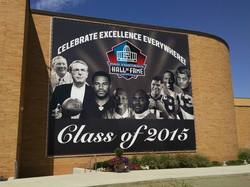 The Hall is easily accessible from Interstate 77 in Ohio. Tickets were $24 per person, with parking set at $10. A little bit pricey, to be sure, but I figured I wouldn't be traveling this way very often, so it was worth the expense. 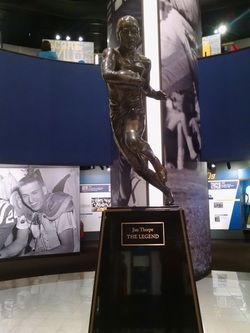 Jim Thorpe gets plenty of exposure here, as do the Canton Bulldogs, Cleveland Browns and Chicago Bears. Lots of collectibles from those eras. This figure of Jim Brown sports a pensive look on the bench. 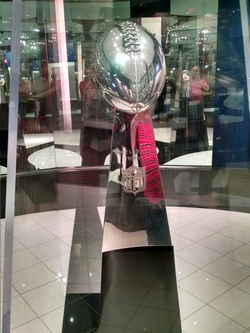 I first saw the Vince Lombardi Trophy in late January 2009 during the NFL Experience when Super Bowl XLIII was held in Tampa, FlLorida. The Steelers and Cardinals played that day (Feb. 1, 2009) at Raymond James Stadium, with Pittsburgh winning 27-23. On Monday, I saw it again, and it was in the center of a small room. It looked fantastic. 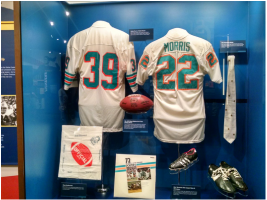 I was a big Miami Dolphins fan when I grew up in South Florida during the 1970s, so seeing this memorabilia from the 1972 perfect season was especially fun. The uniforms of Larry Csonka (39) and Mercury Morris (22) is balanced off nicely by the homemade tie of kicker Garo Yepremian. 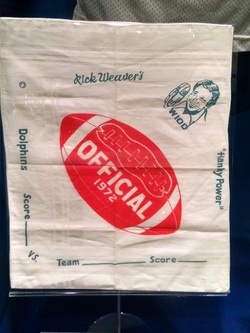 "Get out those white hankies," WIOD radio announce Rick Weaver - the voice of the Miami Dolphins - would tell his listeners after the '72 Dolphins scored a touchdown. Here is one of those specially made hankies. There are some nice colorful murals of Hall of Famers that dot the walls. 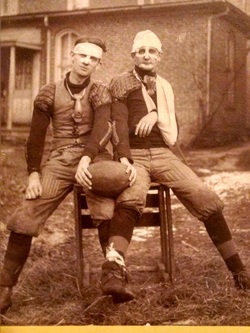 There is even some room for humor at the Hall of Fame, as this vintage photo suggests. Players who didn't wear the proper kind of equipment were destined to suffer some bumps and bruises. 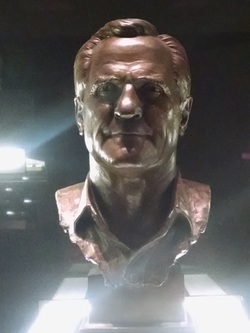 The room with the busts of the Hall of Famers is very impressive, and this is what fans visiting the Hall enjoy looking at. The likenesses are pretty much dead on, as this bust of coach Don Shula proves. 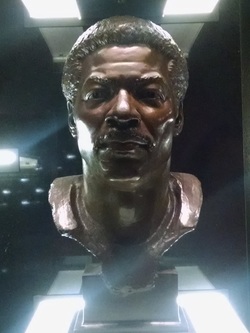 Lee Roy Selmon, the first Tampa Bay Buccaneers player to be enshrined in Canton. Ferocious on the field, but always a gentleman away from the gridiron. 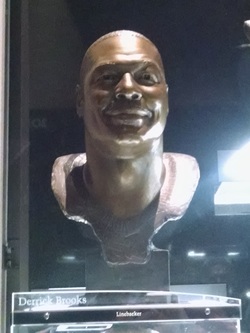 More class. Another one of the best, on and off the field -- former Bucs linebacker Derrick Brooks. 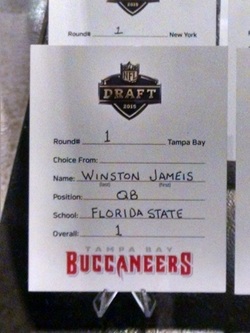 Here is the actual card used by the Bucs to draft Jameis Winston No. 1 in this year's NFL draft. The other cards were also in this case, in numerical order. Very interesting. There are lots of videos and interactive stations located throughout the Hall. Football fans of all ages can enjoy them; push a button, and the Immaculate Reception comes to life. Push another button and the Music City Miracle unfolds. Push still another button, and the infamous Holy Roller play develops in front of you.
There are uniforms from the past and lots of newspaper clippings and photographs. A casual fan could get through the Hall in an hour; if you are more hardcore, plan to spend at least two. The merchandise is expensive, but then again, no more pricey than at an NFL stadium on game day. It was a nice visit. 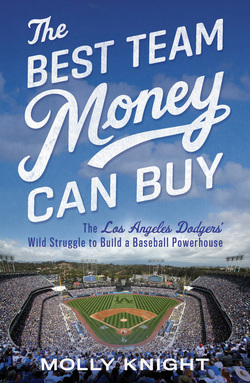 As baseball enters the second half of the 2015 season, the Los Angeles Dodgers sit atop the National League West. Expectations run high for a team with the highest payroll in major-league baseball, and the Dodgers have been here before. They made it to the NLCS in 2008, 2009 and 2013, but they haven’t been to the World Series since Los Angeles topped Oakland in 1988. When the Guggenheim Partners bought the Dodgers from Frank McCourt for a staggering $2.15 billion in 2012, controlling partner Mark Walter went on a spending spree to put the team over the top. But as George Steinbrenner and the New York Yankees learned when the Boss threw cash at free agents during the 1980s and early 1990s, money can only take a team so far. “Being the richest team wasn’t as important as being the smartest,” Molly Knight writes in her new book, “The Best Team Money Can Buy: The Los Angeles Dodgers’ Wild Struggle to Build a Baseball Powerhouse” (Simon & Shuster; hardback; $26; 324 pages). Knight, who covered baseball for ESPN: The Magazine for eight years, tells the story of the 2013 Dodgers, calling them a group of players who “were less a team than they were twenty-five separate corporations." It rings true. The Dodgers had brilliance with pitcher Clayton Kershaw, who won the NL Cy Young Award in 2013 with a 16-9 record, a 1.83 ERA and 232 strikeouts. Kershaw has led the league in ERA the past four seasons and won 72 games between 2011 and 2014 — but he has been 1-5 in the postseason and collapsed in Game 6 of the NLCS. Cuban refugee Yasiel Puig took baseball by storm with an outstanding rookie season — 19 homers, 42 RBIs and a .319 average — but his quirks and work habits made him no friends in the Dodgers locker room or around the league. In a vivid, descriptive style that sharply defines this book, Knight writes that Puig “stood six foot three and weighed 240 pounds but carried it high in his chest and shoulders, like a wild animal that raised its hackles to look bigger to enemies.” Matt Kemp was a talented but injury-prone outfielder who sulked when he wasn’t starting or was playing out of position. Meanwhile, teams like the San Francisco Giants and St. Louis Cardinals have spent less money but have had more success because they understood that a team concept, smart trades and developing their minor-leaguers were better investments. The Giants have won three World Series since 2010, while the Cardinals have won two National League pennants and won the Series in 2011. Knight gives the reader a behind-the-scenes look at how the Dodgers tried to do the same. It hasn’t been an easy road, as the new ownership group (which includes NBA legend Magic Johnson), attempted to transform the Dodgers into “the Lakers on grass.” Winning wasn’t enough; the group wanted to field a team with enough star power to impress Hollywood’s biggest stars, and in doing so, “hoped to captivate a nation obsessed with celebrity.” Knight’s strength in this book is her clarity, which is also peppered with some colorful analogies. Colorful, but not overdone or forced. She notes, for example, that “the advent of the Internet transformed baseball from a children’s game to a chew toy for adult control freaks and obsessive-compulsives.” That would include the inner workings of how the Guggenheim group acquired the Dodgers, as the partnership paid an exorbitant amount because Walter correctly anticipated the lucrative television revenues that would kick in. And it did: Time Warner paid $8.35 billion for 25 years of Dodgers broadcast rights. That gave the Dodgers even more money to operate with, and they used it in August 2012 to land big-name players like Adrian Gonzalez, Josh Beckett and Carl Crawford. Knight also shows how manager Don Mattingly, whose job seemed to be in jeopardy after a 30-42 start in 2013, maintained a steady course and guided his team to the playoffs. That helped the Dodgers go 42-8 after that slow start to take command of the NL West and win the division by 11 games. They beat the Braves in the NLDS before falling to St. Louis in the NLCS, when Kershaw was roughed up by the Cardinals in Game 6. The Dodgers’ success occurred despite some personality conflicts. Knight mentions an incident where Puig and pitcher Zack Greinke nearly came to blows in Chicago when the pitcher tossed Puig’s suitcase off the team bus. Puig and Kemp also had a few run-ins during the season. And after the season, the normally even-keeled Mattingly had a few sharp words for upper management. “The Best Team Money Can Buy” is an excellent example of how money can only go so far in creating success in major-league baseball. Certainly, a franchise with deep pockets can outbid the competition, but it takes chemistry, careful planning, shrewd deals and sometimes just plain luck for a team to win it all. While the Dodgers appeared to be a lock in the 2013 playoffs, that didn’t happen. Knight gives a respectful nod toward legendary broadcaster Vin Scully, paraphrasing one of his signature on-air calls to describe the Dodgers’ downfall: “In a season of improbable highs and lows, the impossible had happened.” Whether the Dodgers’ cash will bring a title this year remains to be seen. But Knight’s description of the 2013 season provides a fresh view of ownership’s philosophy and how the group hopes that approach will result in Walter hoisting that World Series trophy. Here is a link to my story on Sports Collectors Daily about college biology professor Brad Balukjian, who randomly opened a pack of 1986 Topps and is interviewing the men featured in the cards for his upcoming book, "Wax Pack":
http://www.sportscollectorsdaily.com/a-pack-of-wax-and-stacks-of-memories/ 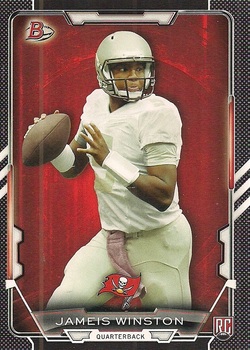 While opening a hobby box of 2015 Bowman football, I was reminded of the 1978 album by Blondie called Parallel Lines. That’s because Bowman football has plenty of parallels to go along with its base set. And with a 110-card base veterans set and 110 additional base rookies, that’s not a bad thing. What’s nice about this product is the packaging — a hobby box has 10 packs containing 25 cards apiece. There’s something really nice about opening a brick-sized pack of cards. 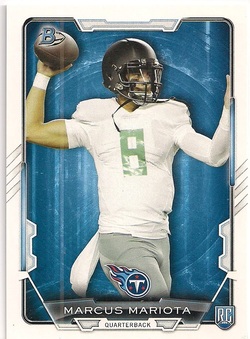 Another nice feature is the autographs a collector will find in a hobby box. Topps is promising four on-card signatures and a relic in each one. And right off the bat, I found an autograph card. 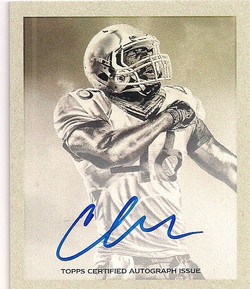 The first pack I opened yielded a 1948 Bowman-style mini of tight end Clive Walford, the former University of Miami player who was drafted by the Oakland Raiders in the NFL draft. The autograph was done with a Sharpie and looks like a bunch of squiggles (so much for the parallel lines references, right?). Later on, I would pull 10 more 1948 mini base cards. 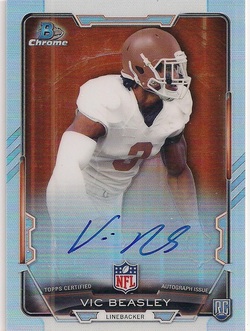 The second autograph was on a regular-sized card. This was a refractor signature card of Vic Beasley, who starred at Clemson and was the eighth overall pick in this year’s draft. The linebacker will be playing for the Atlanta Falcons. The third autograph was of another Hurricanes alum — offensive tackle Ereck Flowers, who was drafted by the New York Giants. This autograph is on a Bowman chrome card, which is nice—but the signature is rushed, has a hint of the letter “E,” a loop and a straight line. I’d like to think Flowers could have done better. 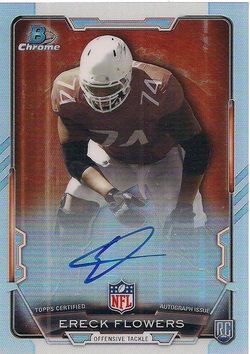 The final autograph was a rookie gold chrome refractor of former Alabama receiver Amari Cooper, who also was drafted by the Raiders. The card is numbered to 75, and the signature is embellished with Cooper’s No. 9 uniform number that he starred in for the Crimson Tide. The relic in the hobby box I opened was of Denver Broncos linebacker Von Miller, numbered to 25. 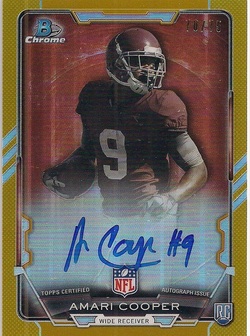 The design is pretty straightforward, with a player’s action photo framed by a white border with … wait for it … parallel lines. The card backs break down into categories like Résumé (player achievements), Skills (self-explanatory) and Up Close (fun facts and trivia). Because of Bowman’s early release date, photos of rookies are airbrushed from their college days. That’s certainly a negative, but if you are aching to rip open packs of football cards before training camps start, this becomes a positive. I pulled 63 of 110 base veterans and 18 black parallels. There were 87 of the 110 rookie base cards, with 38 black parallels. Interestingly, I found a Marcus Mariota card among the base rookies, but Jameis Winston showed up as a parallel. Still, it was good to get the two top names from the 2015 NFL draft.
Rookie black parallels fall four to a pack, while there are two veteran black parallels per pack. And to be honest, if I am going to get a bunch of parallels, I’d prefer them to be rookies, rather than vets. There were eight Rainbow Black Veterans and six Rainbow Black Rookies. Rainbow Black On average, each hobby box will contain a pair of Silver Ice parallels. The cards I pulled were a veteran (Percy Harvin) and a rookie (Josh Robinson). There were three Blue Rainbow Parallels, numbered to 499, and an additional Rainbow blue numbered to 99 (C.J. Spiller). Gold Parallel checked in with one card numbered to 399 (Shane Ray), along with an Orange numbered to 299 (Tyler Lockett) and Red (David Johnson, numbered to 199). The lowest-numbered parallel I pulled was an Orange Ice card of Sean Mannion, numbered to 50. Die Cut cards are merely jigsaw puzzle versions of the base cards. On average, a collector can expect to find three of these cards. My three guys were a pretty decent group: Kelvin Benjamin, Peyton Manning and Philip Rivers. Overall, a nice set. The design is clean, the photography is good — except for the airbrushing, but that it something out of Topps’ control; there just wasn’t enough time to get photos of rookies in their new pro uniforms. And there is a good assortment of autographs and parallels. Lots of parallels. Here is the link to a story I wrote for Sports Collectors Daily about Challenge the Yankees, a 1960s board game:
http://www.sportscollectorsdaily.com/challenge-yankees-set-tough-make-grade/ Just cut and paste the URL. 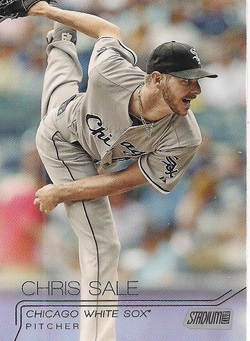 Topps Stadium Club returns in 2015 with many of the elements that made it successful in 2014, but there are a few twists. The biggest one is in the product’s packaging. No longer is the hobby product a three-headed mini-box set; this year, Stadium Club’s hobby box has 16 packs, with eight cards to a pack. The major lure of Stadium Club has been its photography. The product was a big hit when it made its debut in 1991 as a 600-card set. Topps made use of full-bleed photography and high gloss to produce one of the nicer sets of the 1990s. The product ran through the 2003 season and took a five-year hiatus before re-emerging in 2008. After another six-year stint on the sidelines, Stadium Club returned in 2014 and is back for a second consecutive year. 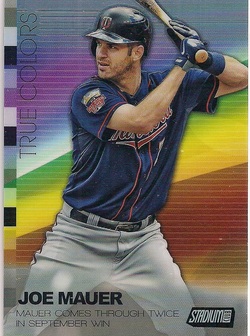 Last year’s product had some vivid photography, but it seems like the 2015 effort is sharper. The full-bleed effect is excellent and the photos seem a lot crisper. They certainly pop , especially with the thin silver foil that is used to name the players and teams. The foil is located near the bottom of the card and is unobtrusive. The design utilizes both horizontal and vertical shots. And while I am a traditionalist in the sense that I enjoy vertical photography, some of the horizontal stuff looks really good. For example, Jared Weaver (card No. 132) is caught in the aftermath of his delivery, and the effect is very strong. Billy Hamilton (card No. 104) is extending himself horizontally to catch a line drive. Carlos Baerga (card No. 168) goes airborne in the classic double play relay to first base . Even non-action shots look good in the horizontal format. Cal Ripken Jr. (card No. 33) is engulfed by a sea of hands as he signs autographs. And Fernando Valenzuela (card No. 1) is also surrounded by autograph seekers. Detail is a key element in a lot of the Stadium Club photos, and viewing a photo of Drew Stubbs (card No. 175) getting drenched by Gatorade is surprisingly not cliché-looking. You can see the ripples of water, and that’s impressive. 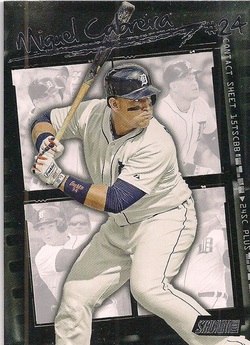 The vertical shots are just as good, with some portrait shots exuding a moody, eye-catching appeal. Jimmy Rollins (card No. 171) looks pensive, while Roger Clemens (card 239) looks focused. Albert Belle (card No. 31) looks intimidating just by crossing his arms, while Mariano Rivera is exuberant after celebrating a big victory. Once again, several Hall of Famers are shown in black-and-white photography, which gives those cards a stark, almost elegant look. They really provide a nice contrast to the "newer" players. Hall of Famers I pulled from the hobby box Topps supplied included Jackie Robinson, Monte Irvin, Orlando Cepeda and a dual shot of Larry Doby with Robinson. One of the more interesting shots shows Frank Robinson in front of his locker, reading a newspaper. 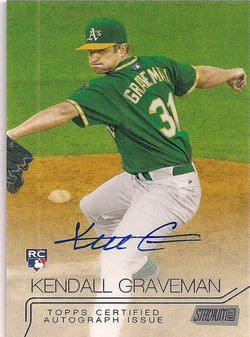 For this year’s Stadium Club, Topps is promising two on-card autograph cards and an insert or parallel in every pack. The base set contains 300 cards. I pulled 110 base cards, eight gold foil parallels and two black foils parallels. It’s easy to miss a parallel, but look closely at the Stadium Club logo; in base cards it is stamped in silver foil, while parallels show the logo (and players’ names) in the parallel’s color. 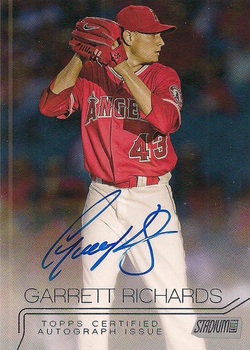 The first pack I opened when I began sampling this hobby box yielded the first of two on-card autographs — Athletics pitcher Kendall Graveman, who displays a very bold, streamlined signature. The second auto was even nicer — a wonderful script from Angels pitcher Garrett Richards. Very bold and readable. Impressive. 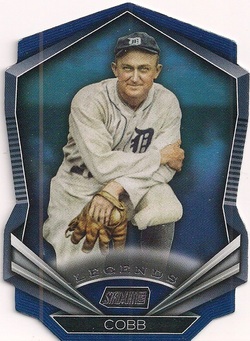 There are several inserts in this year’s set. True Colors is a 25-card set that highlights some of baseball biggest gamers. I pulled two of these inserts: Joe Mauer and Tom Seaver. Contact Sheet inserts are new to the product and resemble those old photography contact sheets used before digital cameras and phones came into vogue. I pulled two of those cards. Legends Die-Cuts is a 10-card insert that spotlights some of the game’s biggest names. I pulled a Ty Cobb card, but others include Hall of Famers like Jackie Robinson, Willie Mays, Ted Williams, Roberto Clemente and Babe Ruth. 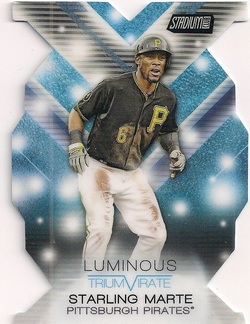 The Triumvirate inserts return. This is one of Stadium Club’s more intriguing inserts. Die-cut cards in this 30-card set are grouped into 10 sets of three cards. Those three cards interlock and can be put together like a small puzzle. These cards fall one to a box; the card I pulled was of Pirates star Starling Marte. Topps Stadium Club is an easy set to collect, is affordable (in the $70 to $85 range for a hobby box) and the eye appeal is excellent.
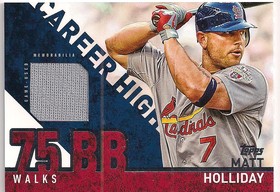 This Matt Holliday relic card features a gray uniform swatch. This Matt Holliday relic card features a gray uniform swatch. The box that Topps sent me had 285 of the 350 base cards, including a variation card of Royals outfielder Lorenzo Cain. Included among the base cards are Future Stars, team cards and Award Winners. 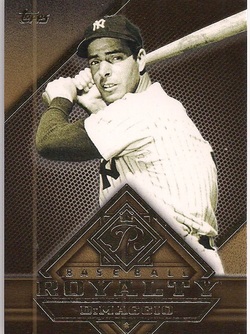 Joe DiMaggio is one of 25 players in Baseball Royalty. Joe DiMaggio is one of 25 players in Baseball Royalty. As usual, Topps sprinkles in parallels, most notably gold numbered to 2015. I found 11 of these cards, four rainbow foil cards and a black parallel of Marlins pitcher Henderson Alvarez numbered to 64. The black parallels are hobby-exclusive cards. Other parallels collectors might find are Snow Camo cards, numbered to 99; pink (50), clear (10) and 1/1 platinum and printing plate cards. Rainbow foil parallels fall every 10 packs. 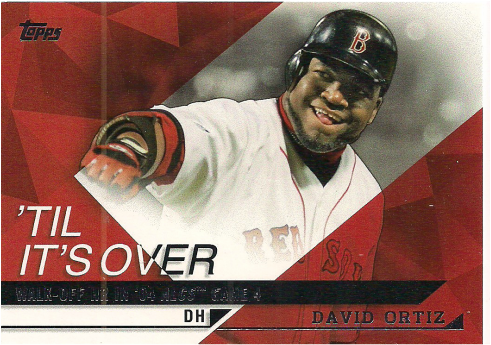 'Til It's Over celebrates some of the most memorable comebacks in major-league history. 'Til It's Over celebrates some of the most memorable comebacks in major-league history. On to the inserts. Highlight of the Year continues from Series One. This is a 30-card set that falls one in every four packs. The theme remains a key moment or feat from that particular season. True to the projected average, I pulled nine of these cards. 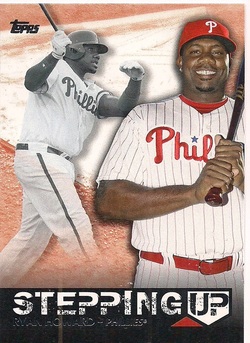 A new insert, exclusive to hobby product, is Baseball Royalty. This is a 25-card subset that includes the game’s greats. There are two per hobby box; the cards I pulled were of Joe DiMaggio and Cal Ripken Jr. Other stars featured include Jackie Robinson, Babe Ruth, Ted Williams, Willie Mays and Hank Aaron. More recent stars like Frank Thomas, Albert Pujols, Chipper Jones and Derek Jeter also are featured. Gold parallels are numbered to 99. 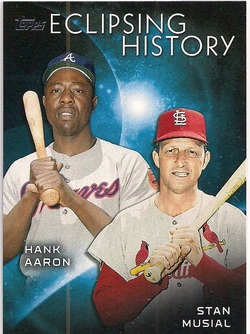 Record breakers past and present are featured. Record breakers past and present are featured. Eclipsing History is a 15-card insert that collectors will find in every 10 packs of a hobby box. It serves a dual purpose, celebrating a record breaker and the player whose mark was broken. I pulled three of these cards. Heart of the Order is a 20-card insert that focuses on the players who bat third and fourth in the lineup, like Giancarlo Stanton, Mike Trout, Jose Canseco, Prince Fielder, Ken Griffey Jr. and Ted Williams. But where is Miguel Cabrera? Well, guess you can’t include every potent bat in a 20-card set. A hobby box will yield six of these cards, and that's what I found. 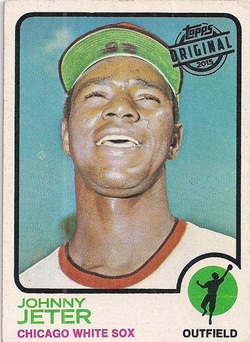 Each hobby box has two stamped buybacks. Each hobby box has two stamped buybacks. Stepping Up is another 20-card set that focuses on clutch performances. Some are devoted to one game or series — Hunter Pence’s effort in the 2014 World Series and Johnny Podres’ heroics in the 1955 Series are two such highlights. Other cards pay tribute to a player’s body of work, like Mariano Rivera’s postseason excellence. Typically, a collector also can find six of these cards in a hobby box, and that's the number I pulled from the box I opened. 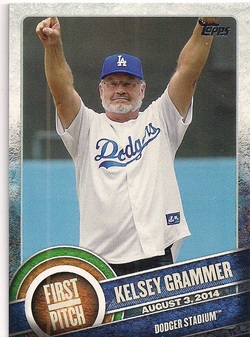 Celebrity tosses continue in Series Two. Celebrity tosses continue in Series Two. ’Til It’s Over is a nice nod to 90-year-old Hall of Famer Yogi Berra, and it echoes the fact that the game is not in the books until the final out is recorded. The 15-card set (a collector should pull four from a hobby box) features David Ortiz’s late heroics in the 2004 ALCS, David Freese’s “one-pitch-away” triple in Game 6 of the 2011 World Series, and Evan Longoria’s 12th-inning home run that capped the Rays’ Game 162 comeback that catapulted Tampa Bay into the 2011 playoffs. I wish Topps had included Bill Mazeroski’s homer that won Game 7 of the 1960 World Series, or even Bobby Thomson’s “Shot Heard ’Round the World” that put the Giants into the 1951 Series. Both homers capped amazing comebacks. 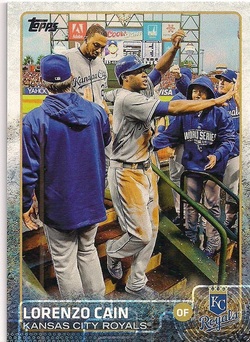 This is a variation of Lorenzo Cain's base card. This is a variation of Lorenzo Cain's base card. Another holdover from Series One is First Pitch. This 10-card set features celebrities like Kelsey Grammer, Stan Lee and Melissa McCarthy. I pulled five of these cards. Topps’ flagship product is ideal for set builders, and it is one I eagerly anticipate each year. The design this year is a good one, and the collation is decent. If I were making the set, I would have included fewer gold parallels and added more base cards in packs — but that’s because I am a big set builder. Still, another solid set. After 36 years in the newspaper business, I became a statistic last week when I was laid off by The Tampa Tribune. A numbers game, you know. Times have changed, and I left with no regrets.
But my passion for writing remains, and I will use this blog to continue to review sports books and, when possible, sports cards. Sports books -- and perhaps books about other topics that interest me -- will be my focus here. All comments welcomed. |
Bob's blogI love to blog about sports books and give my opinion. Baseball books are my favorites, but I read and review all kinds of books. Archives
September 2023
Categories |



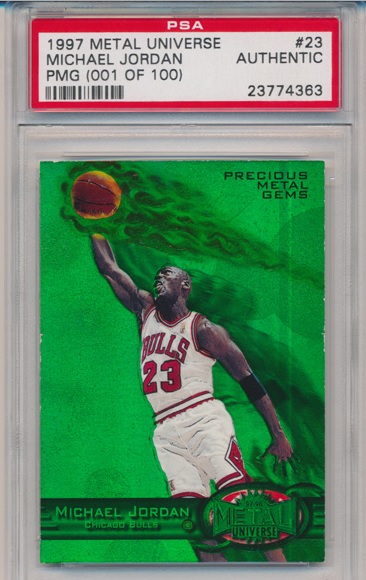
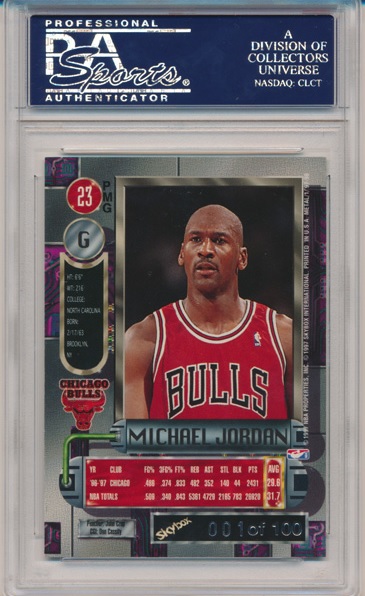
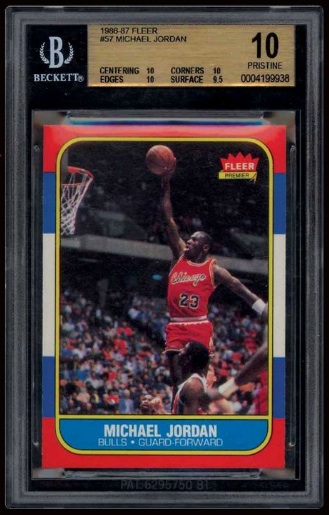
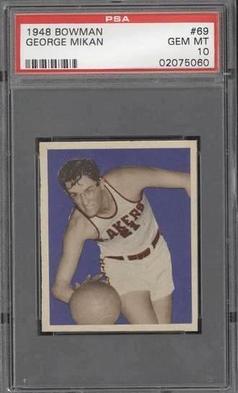

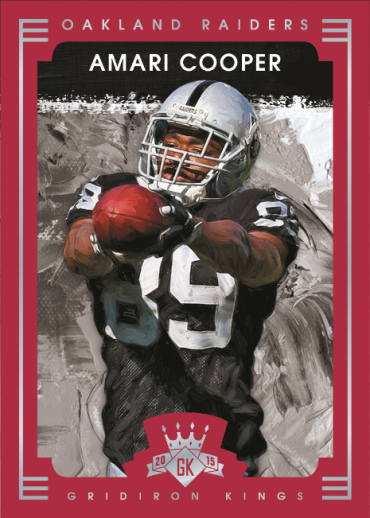
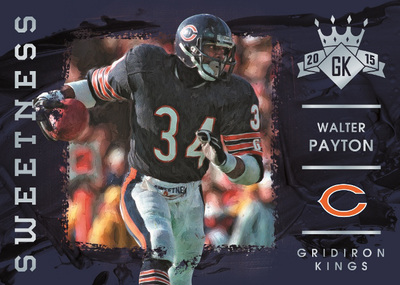
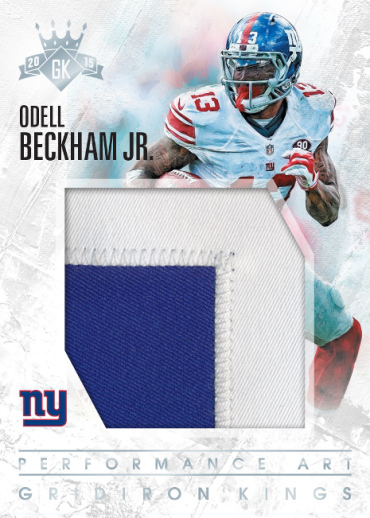
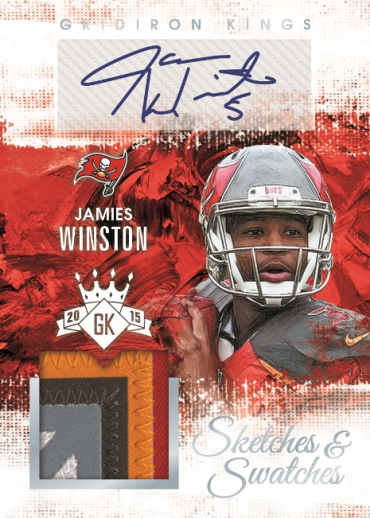
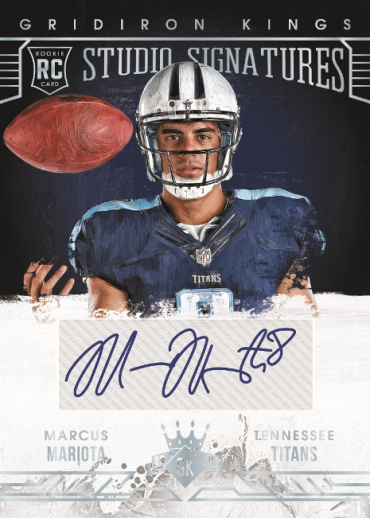
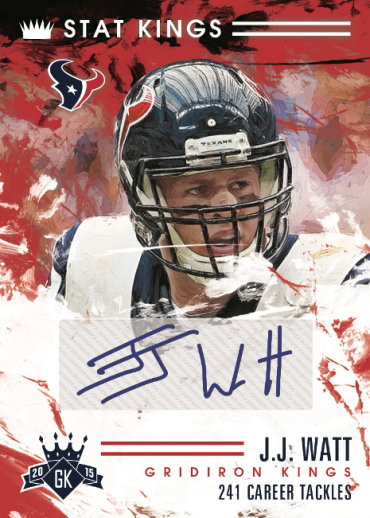
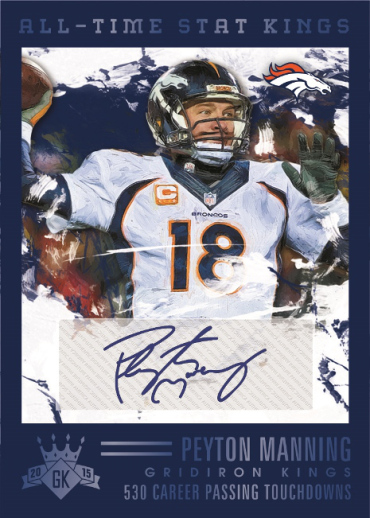
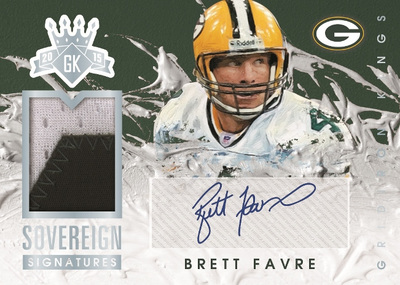
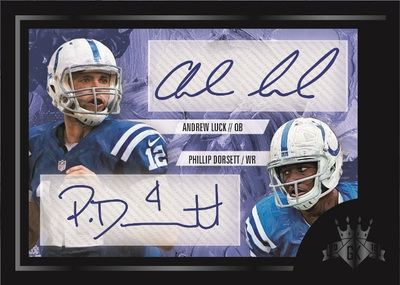

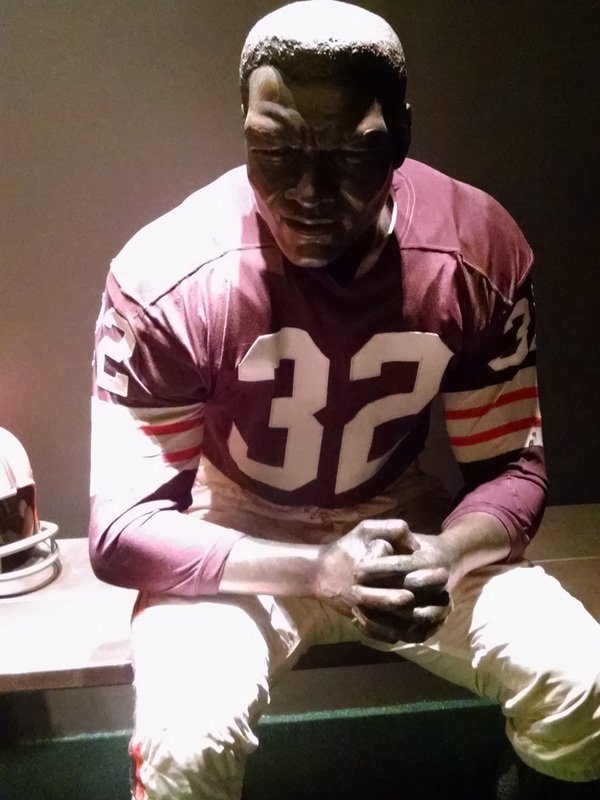
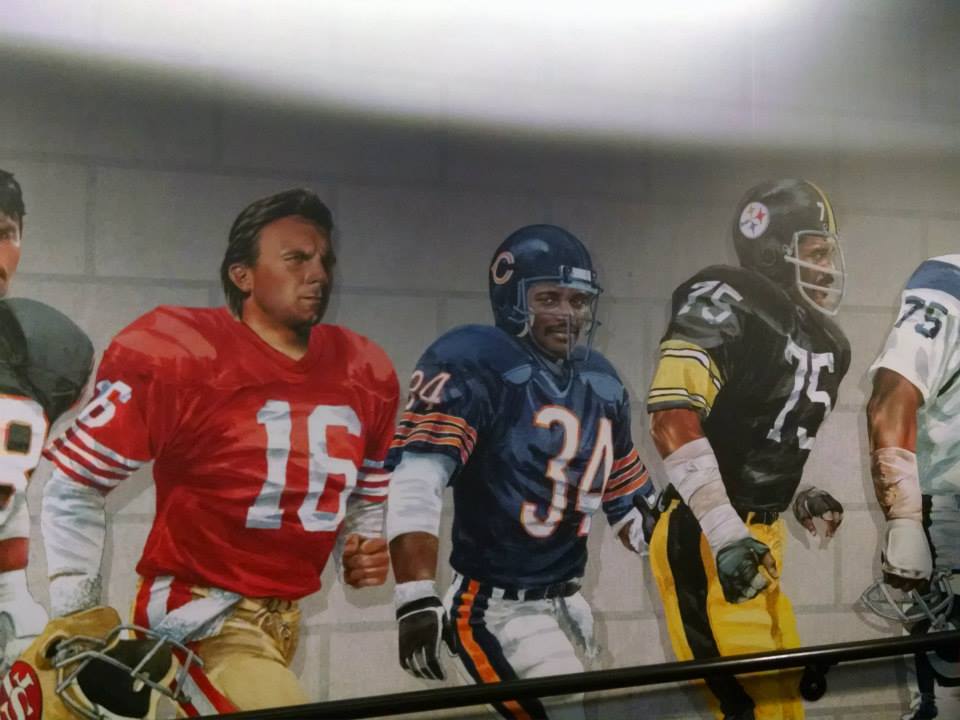
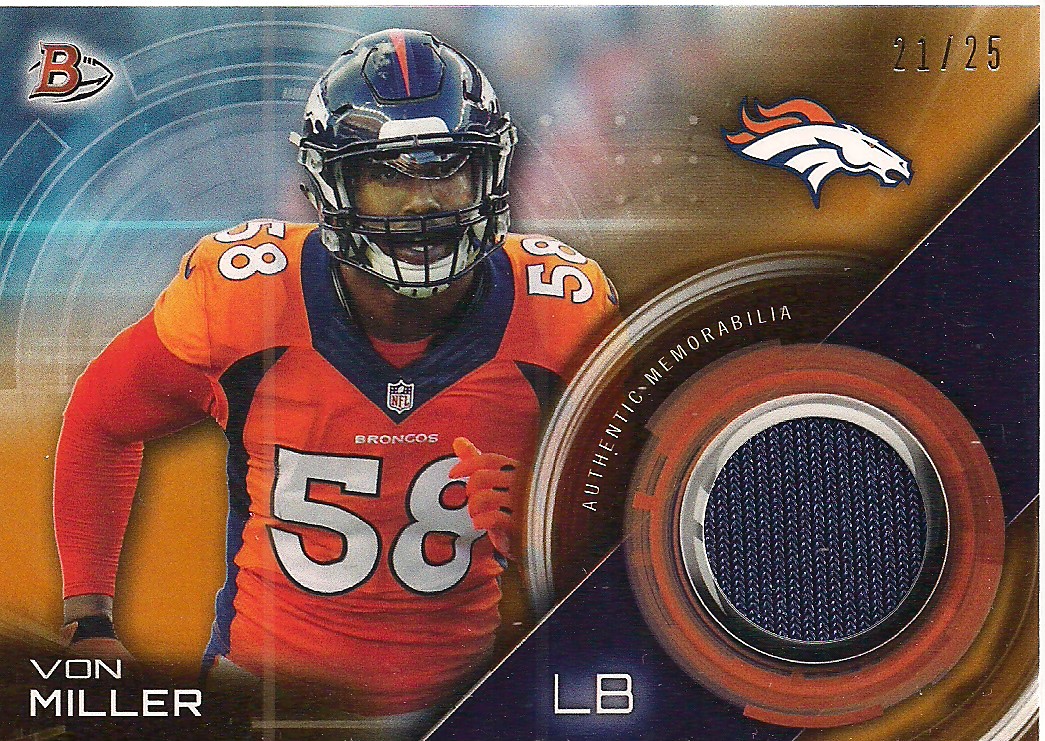
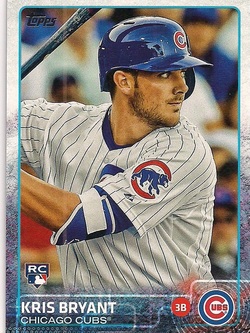
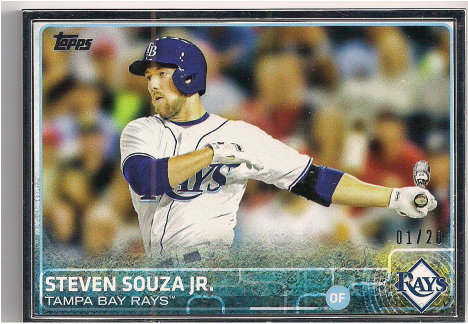
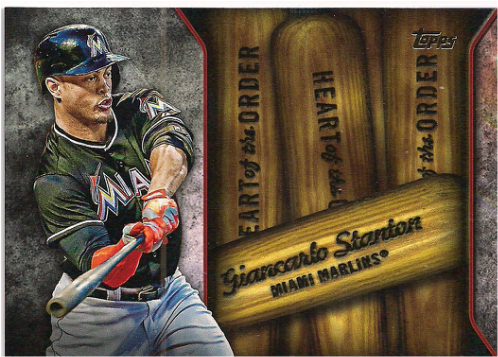
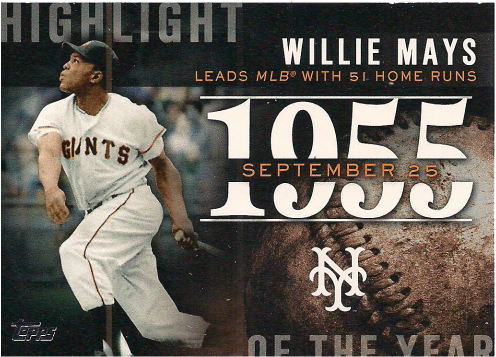
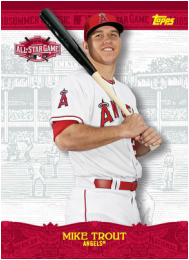
 RSS Feed
RSS Feed
